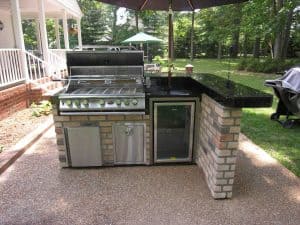Many home owners enjoy t he summer months — and sometimes spring, fall and winter, too — with the sizzle of their outdoor grills. But running back and forth between the kitchen and the barbeque can be a hassle.
he summer months — and sometimes spring, fall and winter, too — with the sizzle of their outdoor grills. But running back and forth between the kitchen and the barbeque can be a hassle.
Outdoor kitchens make life easier for those who enjoy grilling their meals and entertaining outdoors, making your deck or patio an extension of your family’s living space. It also can enhance your home’s resale value.
With proper planning, you also can enjoy your meals in the great outdoors. Here are some factors to consider when determining if an outdoor kitchen is right for your family.
What works best in your space?
Outdoor kitchens can be as elaborate — or as simple — as you’d like. But to make the most of your new space, you need to carefully consider the design.
Think about how the space will be used. Do you want guests to eat outside or just mingle while you cook? What features (pool, trees, etc.) are already in your back yard and need to be worked around? Is there enough ventilation area so smoke from the grill can blow away?
Have a professional check the patio or deck where you plan on building your outdoor kitchen. While most can support the additional weight, you may need to add structural support.
Make sure there is plenty of space for people to gather without getting in the way or being too close to open flames. Typically, there should be 3 feet of space on either side of the grill for work space and food preparation.
How often will you be using your outdoor kitchen?
This will determine numerous factors, including the equipment you purchase. If you will use your outdoor kitchen just in the summer, a grill with wheels can be moved into the garage and protected from the elements once the seasons change. These types of grills are the most common and come in a wide variety of sizes and prices with a range of features.
If you want to use your outdoor kitchen year-round, consider a built-in grill. Look for one with side burners in the base unit that allow for cooking at different temperatures simultaneously. This base can provide extra countertop and storage space.
Make sure the grill is in an area that can withstand high temperatures and is impervious to stray embers or sparks, such as a stone patio. You won’t be able to take it with you if you move, so think carefully before investing a lot of money in a permanent grill.
Take into account your lighting needs. If you eat or entertain into the dark evening, you’ll want direct light for the work area so you can monitor the progress of the meat. Softer lighting works well for socializing areas.
What other equipment do you need?
Standard grill accessories include griddles for grilling fish and vegetables, a meat thermometer and tongs. An exhaust hood for a built-in grill will keep smoke out of your guests’ eyes. Refrigerators with ice makers are ideal for storing beverages and food that needs to be kept cold. An outdoor sink makes prepping and cleaning veggies an easy task. Unless you plan on washing dishes outside, a cold water connection is all you need.
For small appliances and stereos, you’ll need outdoor GFCI outlets. Consult with a professional electrician for local code requirements. Consider purchasing patio heaters or an outdoor fireplace if you plan on grilling in the chilly months.
For those days with inclement weather, you’ll want to get a cover for your grill. Select weatherproof materials for countertops, cabinets, and other elements of your kitchen. Stainless steel, slate, tile, stucco and stone all work well. A large tent or outdoor umbrella can cover your guests and equipment and provide shelter from the sun or rain.
Article compliments of www.nahb.org
Recent Comments